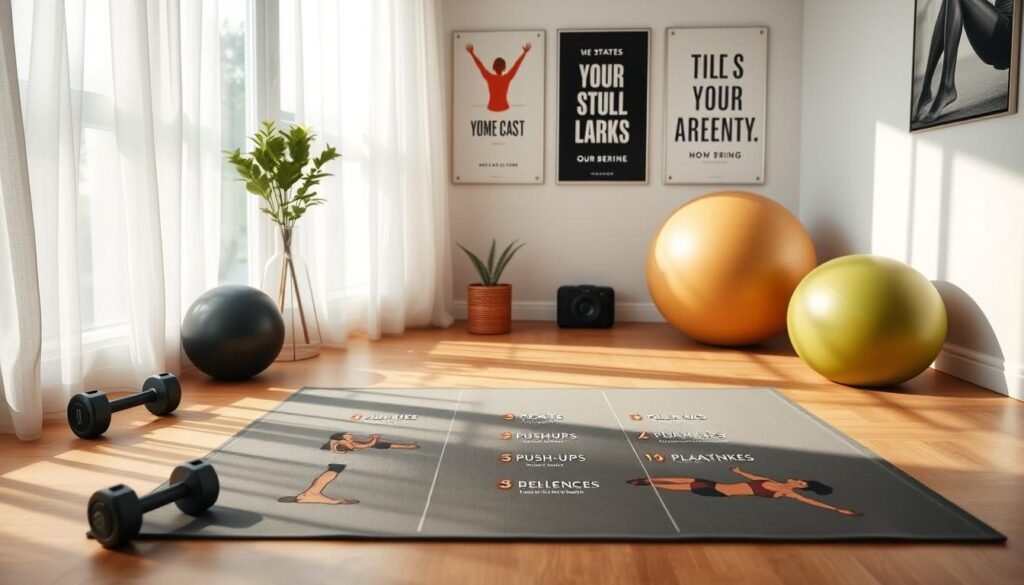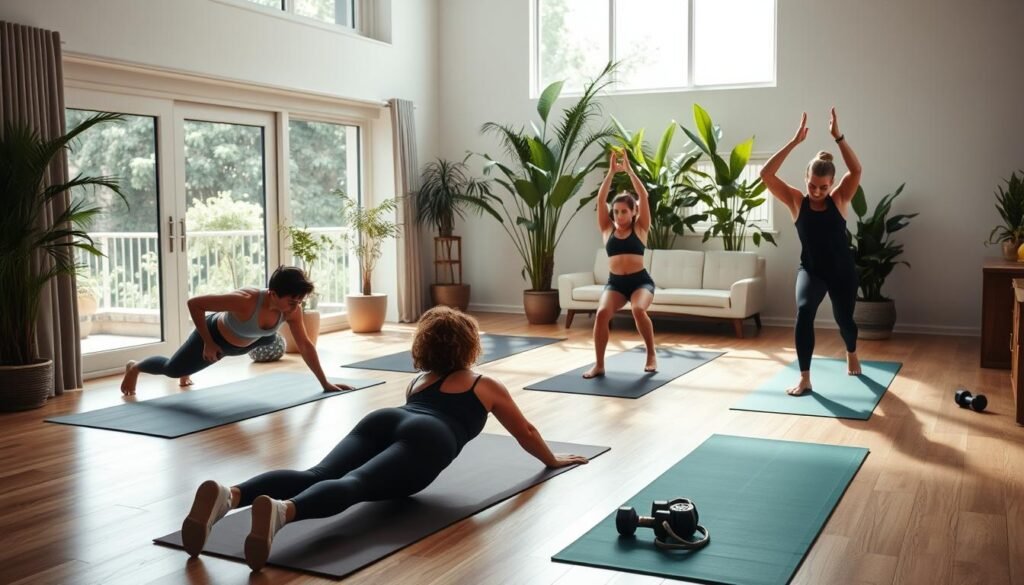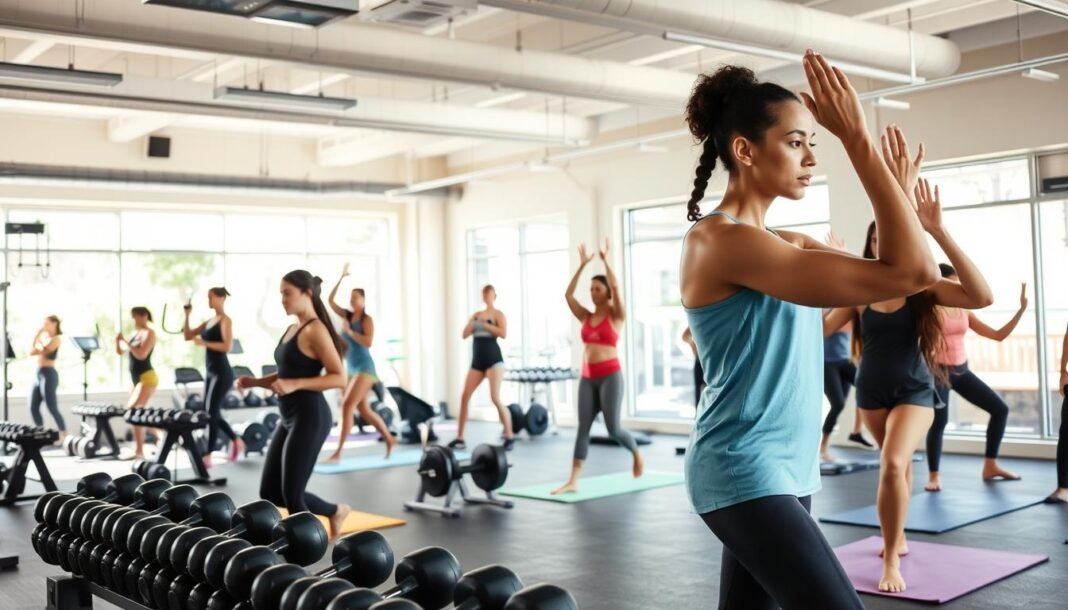Starting a fitness journey can feel overwhelming with all the workout plans out there. But there’s good news. For every fitness level, from beginners to pros, there are tailored workout routines. This means it’s easier to start than you might think.
Whether you’re new to exercise, looking to get stronger, or want to challenge yourself, finding the right routine is crucial. By choosing a program that fits your body and skill level, you’ll improve your health and happiness. Let’s dive into how these tailored workout routines help everyone.
Key Takeaways
- Workout routines can be personalized for every fitness level.
- Understanding your fitness level is crucial for choosing the right exercise plans.
- Effective fitness routines contribute to overall health and motivation.
- Beginner, intermediate, and advanced routines each have unique benefits.
- Adapting your workouts to personal goals leads to greater success.
Understanding Fitness Levels
Gaining knowledge of fitness levels is key to effective exercise plans. Each stage—beginner, intermediate, advanced—has its own needs and training methods. Knowing your current fitness level helps create a safe, effective fitness journey.
Beginner: Starting Your Fitness Journey
Starting with beginner workouts is essential for newcomers. It’s important to learn basic movements and keep good form. This builds a strong base for future fitness growth.
- Start with basic exercises such as bodyweight squats, push-ups, and lunges.
- Incorporate stretching routines to improve flexibility and reduce the risk of injury.
- Set realistic, achievable goals to maintain motivation.
Intermediate: Building on Your Progress
Intermediate fitness brings new challenges. It involves increasing workout intensity and variety to build strength and endurance. Pushing your body in new ways is key.
- Incorporate weights or resistance bands into your workouts.
- Experiment with different exercise formats, such as circuit training or interval workouts.
- Track progress to identify strengths and areas for improvement.
Advanced: Maximizing Your Potential
Advanced athletes should fine-tune their techniques and aim for peak performance. Adjusting workouts to reach specific goals is crucial. Tracking progress helps tailor their training perfectly.
- Implement high-intensity interval training (HIIT) to boost cardio and strength simultaneously.
- Explore specialized programs that match competitive goals.
- Prioritize recovery to prevent burnout and overtraining.
| Fitness Level | Focus Areas | Recommended Workouts |
|---|---|---|
| Beginner | Form and basic movements | Bodyweight exercises, yoga |
| Intermediate | Progressive overload | Weight training, circuit workouts |
| Advanced | Performance enhancement | HIIT, specialized strength training |
The Importance of Personalized Workout Routines
Creating personalized workout routines is key to hitting fitness goals. Knowing your personal fitness goals is the start. This leads to a workout plan that fits you best. Whether it’s losing weight, building muscle, or boosting stamina, your routine should target these goals specifically. If you are looking for the best Website, you can Visit here for more information: https://www.dietpills.com.au/
Identifying Individual Goals
Knowing what you aim for helps make a workout that’s right for you. You might want to:
- Improve overall health
- Increase muscle strength
- Boost athletic performance
This way, you can focus your efforts on what’s important. This makes reaching your fitness targets easier.
Adapting Workouts to Your Lifestyle
It’s important your workouts fit your daily life. You might:
- Do shorter sessions when busy
- Try different exercises to keep things interesting
- Pick activities for either home or gym
Fitting exercise into your life helps you stick with it, and makes it fun. A customized approach means you’re likelier to keep going and enjoy the benefits.
Workout Routines for Beginners
Starting your fitness journey can feel tough, yet beginner workouts are here to help. They build strength and boost confidence. With key exercises, you can start living healthier. It’s also important to do these movements correctly to avoid injury and keep improving.
Essential Exercises to Get Started
Adding fundamental exercises to your workout makes it well-rounded. Here are some key exercises for beginners:
- Push-ups: They’re great for the chest, shoulders, and triceps. If full push-ups are hard, try starting on your knees.
- Squats: Fantastic for the lower body, focusing on thighs, hips, and glutes. Remember to keep your back straight and push through your heels.
- Lunges: They boost leg strength and balance. Step forward, lowering your back knee towards the floor.
- Planks: Perfect for core stability. Maintain a push-up position, keeping your body straight and tightening your abs.
Creating a Simple Weekly Exercise Schedule
Having a weekly exercise plan is key for improvement and rest. Mix strength training with days of rest. Below is a beginner-friendly weekly exercise schedule:
| Day | Workout |
|---|---|
| Monday | Push-ups, Squats, Planks (3 sets of 10 reps each) |
| Tuesday | Rest |
| Wednesday | Lunges, Planks (3 sets of 10 reps each) |
| Thursday | Rest |
| Friday | Push-ups, Squats, Lunges (3 sets of 10 reps each) |
| Saturday | Active recovery (light walking or yoga) |
| Sunday | Rest |
This routine balances workouts and rest. It’s a solid foundation for your fitness path.

Intermediate Fitness Routines
If you are getting comfortable with your fitness routine, it’s time to level up. Intermediate fitness routines push you further. They slowly increase the challenge in your exercises. This helps avoid hitting a standstill in progress.
Progressive Training Programs for Continued Growth
Progressive training keeps your workout exciting and effective. You can do this by gradually adding more weight or doing more reps. This approach helps you get stronger, last longer, and become fitter. A good plan might have these:
- Slowly adding weight in strength exercises.
- Workouts that target several muscle groups at once.
- Planned breaks to make sure you recover well.
Incorporating More Challenging Exercises
To push past your limits and get better, add harder exercises to your routine. Try things like weighted squats, deadlifts, and circuit training. These make your body work harder. They help your muscles grow and make your heart stronger. Here are some tough exercises:
| Exercise | Description | Benefits |
|---|---|---|
| Weighted Squats | Squats with added weight for lower body strength. | Builds leg muscles and core stability. |
| Circuit Training | A combination of various exercises performed in succession. | Improves cardiovascular fitness and muscle endurance. |
| Deadlifts | Lift a barbell from the ground to hip level. | Strengthens posterior chain and overall strength. |
Adding these tough exercises truly ramps up your routine. It’s about going beyond and keeping things interesting. This way, you stay on track with your fitness goals.
Advanced Workout Routines
For advanced athletes, it’s key to push limits to reach top performance. High-intensity workouts boost heart health and build strength. A detailed strength program, aimed at specific targets, helps athletes get ready for contests.
High-Intensity Training Plans
High-intensity training is all about intense activity bursts with rest in between. It makes workouts more efficient and boosts both aerobic and anaerobic fitness. To get the most out of this, try adding:
- Tabata: 20 seconds of high effort followed by 10 seconds of rest, repeating for four minutes.
- Circuit Training: Perform a series of exercises back-to-back with minimal rest.
- High-Intensity Interval Training (HIIT): Alternate between high-intensity work and lower-intensity recovery stages.
Competing: Strength Training Regimen Essentials
A solid strength training program is crucial for competitors. To improve your routine, focus on these elements:
- Periodization: Rotate through endurance, strength, and power phases for best outcomes.
- Specialized Movements: Add multi-muscle lifts like squats, deadlifts, and bench presses.
- Nutritional Considerations: Eat well to support your workouts and rest.
These advanced routines can help athletes reach their competitive goals.
| Training Method | Duration | Focus |
|---|---|---|
| Tabata | 4 minutes | Cardio and power |
| Circuit Training | Varies | Strength and endurance |
| HIIT | 20-40 minutes | Cardio and strength |
At-Home Workouts: Making Fitness Accessible
Working out from home lets you stay fit without needing a gym. You can set up a home gym that works for all fitness levels. It saves time and cuts costs on memberships and travel.
Building a Home Gym on a Budget
It’s possible and fun to make a home gym without spending much. Here are some key items to boost your workouts:
- Resistance bands: They’re cheap and flexible, great for many exercises.
- Dumbbells or kettlebells: Weights like these are great for building strength.
- Yoga mat: Perfect for floor workouts and yoga, offering comfort and grip.
- Sturdy chair or bench: Great for exercises that need elevation or support.
- Everyday items: You can use things like water bottles or backpacks for extra weight.
Effective Bodyweight Workouts for All Levels
Bodyweight workouts are excellent if you prefer not to use equipment. They can be done anywhere and fit any skill level. Try adding these exercises to your workout:
- Push-ups: They work the chest, shoulders, and triceps.
- Squats: Squats improve strength and stability in the lower body.
- Plank: This move strengthens the core and helps fix posture.
- Lunges: Lunges increase endurance and balance in the lower body.
- Burpees: A mix of strength and cardio, burpees offer a tough workout.

These tips and exercises make it easy to keep up with fitness at home. You won’t be held back by location or money issues.
Gym Routines: Maximizing Your Time
Looking to make the most of your gym time? Using efficient strategies can change everything. Time-efficient workouts help you fit exercise into a busy life. With the right gym routines, reaching fitness goals doesn’t need hours every day.
Time-Efficient Gym Workouts
Workouts like High-Intensity Interval Training (HIIT) or super-setting keep intensity up and downtime low. They boost heart health and muscle growth. Consider this routine:
- 5-minute warm-up (jogging or dynamic stretches)
- 20 seconds of intense exercise followed by 10 seconds of rest, repeated for 8 rounds (e.g., burpees, kettlebell swings)
- Strength training super-set (e.g., bench press followed by rows with minimal rest)
- 5-minute cool-down period (static stretches)
Choosing the Right Equipment for Your Goals
Choosing the right equipment is key to meeting fitness goals. Resistance machines are good for controlled movements. Free weights offer more motion and engage more muscles. Knowing these differences helps you craft gym routines that work.
| Equipment Type | Best For | Advantages |
|---|---|---|
| Resistance Machines | Beginners, isolation exercises | Ease of use, safety |
| Free Weights | Advanced, compound exercises | Greater stabilization, functional strength |
| Bodyweight Equipment (e.g., resistance bands) | All levels, travel-friendly workouts | Versatility, portability |
Mixing equipment types with time-saving workouts leads to effective gym sessions. This custom approach keeps you motivated and moving forward on your fitness path.
Cardio and Strength Training Integration
Mixing cardio with strength training brings many perks. This method helps with weight control and boosts heart health and stamina. By combining both, you get a well-rounded fitness plan that meets different goals.
Benefits of Combining Cardio with Strength Training
When you mix cardio with strength exercises, they work better together. You get:
- Improved cardiovascular health: Cardio makes your heart and lungs stronger.
- Enhanced muscle definition: Lifting weights grows and tones your muscles.
- Increased calorie burn: Doing both exercises burns more calories.
- Boosted metabolism: This combo keeps your metabolism high after exercising.
- Improved overall stamina: It leads to greater endurance and performance.
Sample Routines for Balanced Fitness
Here’s how you can mix cardio and strength training in a week:
| Day | Cardio (Duration) | Strength Training (Duration) |
|---|---|---|
| Monday | 30 minutes running | 30 minutes upper body exercises |
| Tuesday | 45 minutes cycling | 20 minutes core stability training |
| Wednesday | 30 minutes swimming | 30 minutes leg workouts |
| Thursday | 25 minutes HIIT | 35 minutes total body strength |
| Friday | 40 minutes brisk walking | 30 minutes circuit training |
| Saturday | 30 minutes jump rope | Rest or light yoga |
| Sunday | Rest day | Rest day |
Adapting Your Routine for Flexibility and Mobility
Improving your flexibility and mobility is vital in fitness. It helps you reach your best performance and lowers the risk of injury. Learning and using effective stretching methods will greatly enhance how fit you feel and move every day.
The Role of Stretching in Fitness
Stretching is key for keeping your joints and muscles flexible. It helps maintain a good range of motion. Doing stretches often can:
- Improve athletic performance by increasing muscle elasticity.
- Reduce muscle soreness after workouts.
- Enhance circulation, which helps in recovery.
- Support overall body alignment and posture.
Incorporating Yoga or Pilates into Your Schedule
Adding yoga or Pilates to your exercise plan helps with flexibility and core strength. These activities encourage a connection between mind and body, leading to clearer thinking.
They offer many benefits:
- Yoga includes diverse poses that assist in relaxation and flexibility.
- Pilates focuses on strengthening the core and improving stability and posture.
- Both are great for better balance and coordination.
Tracking Progress and Staying Motivated
Getting fit is more than just hard work. It’s about tracking your progress and keeping motivated. Using fitness apps and tools helps keep you on track and focused. They give insights into your fitness routine, which helps keep up your enthusiasm and commitment.
Utilizing Fitness Apps and Tools
There are many fitness apps out there. Each one is designed to help you keep track of activities, watch what you eat, and check your progress. Popular apps like MyFitnessPal, Fitbit, and Strava let you log workouts, track heart rates, and follow nutrition plans. These apps make your workout experience more interactive, help you meet fitness goals, and improve your workout quality.
Setting Achievable Milestones
It’s important to set realistic goals that you can actually reach. Breaking big goals into smaller ones makes the journey enjoyable and rewarding. Celebrating these small wins keeps up a feeling of success. This lets you see and value your progress over time. You might use a chalkboard or a digital list to see these milestones. It’s a good reminder of how far you’ve come in your fitness journey.
| Fitness App | Key Features | Best For |
|---|---|---|
| MyFitnessPal | Calorie tracking, food database, exercise logging | Nutrition-focused individuals |
| Fitbit | Activity tracking, sleep monitoring, heart rate monitoring | Wearable technology users |
| Strava | Activity tracking, route planning, community features | Athletes and runners |
Conclusion
Starting a fitness journey is a big step. It’s important to know about different workout routines. This knowledge helps everyone, no matter your level. Whether you’re a beginner, enhancing your skills, or aiming high, there’s a routine for you. The main goal is to pick a plan that matches your health goals and fits your daily life.
Being consistent and patient is key to a good fitness plan. As you try different workouts, remember that results take time. Celebrate every small win. Each step is part of the journey to better health.
The best workout is one you enjoy and keep doing. By including strength training, flexibility, and other elements, you can create a full fitness plan. This plan will not only reach your health goals but also improve your life in the long run. Now, it’s time to start and explore a healthier you!
